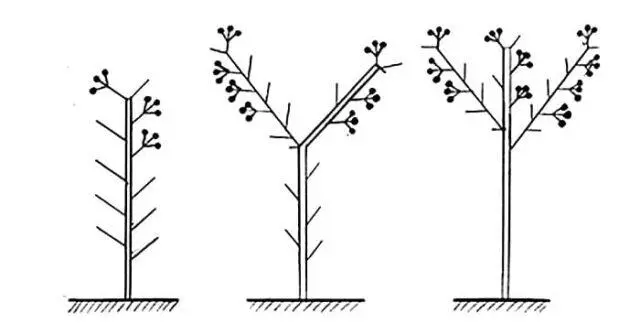Contents
It is necessary to form eggplants in open ground in cases where the bushes are tall enough and grow well. Usually they are led in 1-2 stems. If the landing is very dense, there is not enough space, it is allowed to lead in 3-4 shoots. To do this, you need to install a support by tying the stems with a rope.
Do I need to form eggplants in open ground
As a rule, the formation of eggplant is carried out in a greenhouse. The reason is obvious – there is not enough space here, not much light comes in, so the bushes need to be kept in 1-2, less often in three stems, so that they give a good harvest. Although many varieties of eggplant give strong, tall bushes with a large number of shoots.
Formation often needs to be done when growing in open ground. This procedure provides several advantages at once:
- Uniform access of light and air to all parts of the plant.
- It is possible to get 1-2 or several strong shoots so that the plant does not waste energy on other branches.
- Prevention of bacterial and fungal diseases.
- It is easier to process the bushes, to care for them.
- It is possible to save space: for example, if you keep bushes in the open field in three stems, they can be planted at a distance of 20-25 cm from each other.
When to form
It is recommended to start work 2-3 weeks after transplanting seedlings of seedlings into open ground. By this time, the bushes should grow to 30-35 cm. Sometimes, due to weather conditions, the dates may shift slightly, so you should focus on the forecast.
If the seedlings develop poorly after transplantation, it is necessary to strengthen feeding, regularly give nitrogen compounds. In this case, you should have time before the appearance of the first ovaries. Therefore, the deadline is the flowering period.

They begin to form when the eggplant grows to 30-35 cm
Preparatory work
At the preparatory stage, several actions should be performed:
- Install a support and tie plants to it. This is done so that the plants do not bend down to the soil due to the severity of the fruit.
- Pinch off the top growing point.
- Treat the wound with wood ash, lime or coal powder.
- Wait for the formation of several shoots and leave the strong ones, remove the rest.
You can work manually or with a pruner. The blades are pre-treated with a solution of potassium permanganate or another antiseptic.
How to properly form an eggplant bush in the open field
The formation of plants in open ground is a fairly simple procedure. If you follow the basic rules, the bushes will not suffer and will give a good harvest. It is recommended to pay attention to several points:
- Work should be started only after the bush reaches a height of 30 cm. In order for it to adapt, the eggplant must be allowed to “rest” for 1-2 weeks before forming.
- After pinching the top point in the open field, you should wait another two weeks to select 1-2 strong shoots. The rest are removed.
- After the branching point is marked and several shoots are selected, all the lower leaves of the eggplant up to this point must be removed. Moreover, it is better to do this not immediately, but in turn, for example, one sheet per day. Then the plant will survive the injuries less painfully.
- When grown outdoors, new shoots periodically appear – they should be removed.
- For proper formation, weak stepsons are pinched after the second leaf above the ovary in such a way that only one fruit remains.
- If you grow eggplants in open ground, all growth points should be removed a month before harvesting. Then the plant will direct all its forces to the formation of fruits, and not green mass.
After pruning, plants weaken, can become emaciated and even suffer from infections. Therefore, it is necessary to provide enhanced care. To do this, the bushes are regularly watered twice a week. Water is preliminarily defended indoors or in the sun. In this case, it is best to water in the late evening and strictly under the root, so as not to burn the leaves. The consumption rate is from 1,5 to 2 liters per bush. This corresponds to 10 liters of water per square meter.

After pruning, it is necessary to ensure regular watering and top dressing.
The soil is periodically loosened, weeding is done. So that it does not dry out too quickly, it is advisable to mulch the plantings with sawdust, needles, hay, straw. Also, during and after pruning, it is necessary to fertilize with an interval of two weeks. At the stage of fruit formation, complex formulations or superphosphate (40 g per 10 l) with potassium sulfate (30 g per 10 l) are given.
If the plantings are too dense, the summer is cold and rainy, this can provoke the development of a fungal infection. If powdery plaque, spots on the leaves are found, it is necessary to treat with special preparations:
- “RAW”;
- “Abiga Peak”;
- “Bordeaux liquid”;
- “Maksim”.
Also, plantings can suffer from aphids, spider mites and other pests. You can destroy them with the help of insecticides, for example:
- “Ephoria”;
- “Biotlin”;
- “Fufanon”;
- “Actara”.
Types of eggplant formation in the open field
In order to properly cut eggplants in the open field, it is necessary to outline the formation pattern. Most often, bushes lead to one or two stems, but it also happens that they leave three or more powerful shoots. The choice depends on the characteristics of the variety, planting density and growing conditions.
Dwarf eggplants can not be formed at all, and tall varieties lead to 1-2 stems. If there is not enough space, you can make a tight fit and form bushes in three stems or more.
One stem
If the variety is tall, the plant is weakened due to adverse weather conditions, diseases or other reasons, it is better to form in open ground in one shoot. This is the simplest case, in which only one strong stem is left, and the rest are pinched.
In this case, the shoot must be tied to a wooden or metal peg dug into the soil. It must be fixed with a rope or cloth. Do not tie with wire, as this will damage the stem of the plant during formation.

In most cases, the bushes lead to 1-2 stems
Two stems
Pruning eggplants in open ground when forming in two shoots is carried out according to the same scheme as in one. In this case, pinch the top point of growth after the bush reaches 30-35 cm. Then they wait for a while, select the two most developed shoots and leave them. All other shoots are removed. You should also cut off the lower leaves of eggplants to the point of branching. They will not give anything to the plant and will only take away nutrients and water from it.
More than three stems
In open ground, the formation of three stems or more is usually not used. This method is typical for greenhouses, where it is enough to simply install supports or stretch the threads in order to support numerous lashes.
The principle of eggplant formation is exactly the same. It is necessary to wait until the bush in the open field grows to 35 cm, then pinch the top point of growth. After that, three or more of the strongest shoots are left. The lower leaves and shoots of eggplants should be cut off to this point. Other branches competing with the main shoots are also pinched.

The scheme of formation in 1-3 stems will help to carry out the procedure correctly
The bushes will turn out compact and will not take up much space. Therefore, they can be placed as tightly as possible.
Common mistakes
During the formation, summer residents sometimes make mistakes that can lead to a partial loss of the crop. To avoid them, it is recommended to follow these rules:
- When working in open ground, it is not necessary to carry out the formation in hot or, conversely, rainy weather. It is better to plan the procedure for a non-hot and dry day (the optimum temperature is 20-25 degrees).
- If the eggplant is weakened, its foliage is twisted, turned yellow, there are signs of disease, it is better not to proceed with the formation. It is necessary to determine the disease or pest and treat it in the open field with special preparations. During the fruiting period, folk recipes or biological agents are used.
- Another common mistake is that summer residents incorrectly determine the timing of eggplant formation in the open field. You need to start the procedure 2-3 weeks after planting in the garden, when the eggplants grow to 30-35 cm.
- After the formation has passed, and several strong shoots are planned, it is necessary to continue to monitor the plants in the open field. It is required to remove extra stepchildren, as well as to control how wounds heal.
- So that the infection does not penetrate through the damage, they must be treated with ash, charcoal powder or liquid lime.
- If the weather is dry, then a few lower leaves should be left. When grown outdoors, they will help the plant survive the dry period.
- If the weather is hot, then the lower foliage of eggplant, on the contrary, is completely removed. This is necessary for the proper formation and prevention of diseases. Otherwise, the foliage may come into contact with open ground and rot.
Conclusion
It is necessary to form eggplants in open ground to obtain a good harvest and prevent diseases and pests. The procedure is not very complicated, the main thing is to start it on time, periodically remove stepchildren and provide normal care.









